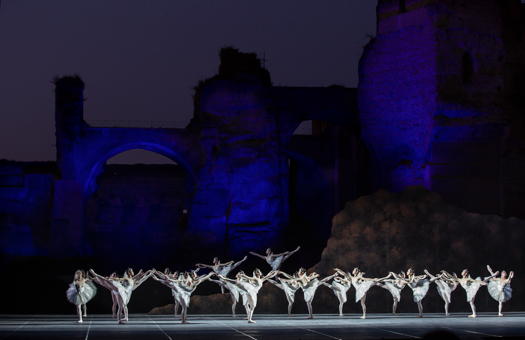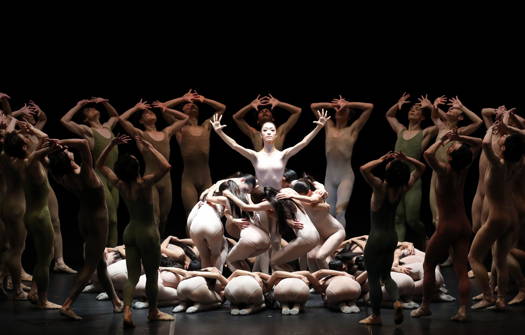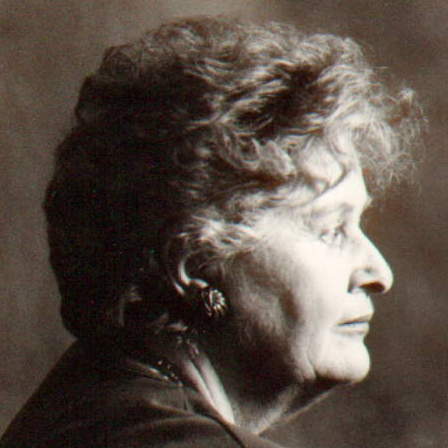- Daniel Auber
- Daishin Kashimoto
- Edizioni Edi-pan
- Roberta Paraninfo
- Bruckner: Symphony No 9
- Cynthia Turner
- Korngold: Theme and Variations
- Motala
Mastery and Versatility
GIUSEPPE PENNISI attends three
Tokyo Ballet performances in Rome
Outside of the ballet world, few people know that one of the greatest choreographers of the twentieth century, Maurice Béjart (1927-2007), left his artistic and professional heritage at the Tokyo Ballet, a company of over a hundred dancers which this year celebrates the fifty-fifth year since its foundation. The company performs not only at major Japanese theaters - it is now on its thirty-fourth international tour. This summer's tour was to Italy, Austria and Poland. The Italian part of the tour began in Rome on 26 June 2019, during the summer opera season at the Baths of Caracalla; I was in the audience.
In Italy, the Tokyo Ballet has been seen several times at La Scala. In Venice, it performed both at La Fenice and in Piazza San Marco. It has also been seen at the Maggio Musicale Fiorentino festival. A total of 120 performances over fifteen tours. The last one was during the summer of 2014 and ended with two spectacular performances within the complex of the Baths of Caracalla. Memory of those evenings is such that it attracted Romans to the open air performance in the vast 4500 seat auditorium. Italians generally know Tokyo Ballet primarily through specialized TV channels and DVDs.
The program presented five-years ago included a triptych of Béjart's choreography with music on tape. This year's program began with a piece by an Austrian ballet composer designed for late nineteenth-century Russian Imperial theatres - The Kingdom of the Shadows from La Bayadère by Léon Minkus, with choreography by Anna Makarova - based on the original by Marius Petipa. It continued with Félix Blaka's 1970 Ballet pour TAM-TAMs et percussions with music by Jean-Pierre Drouet and Pierre Cheriza. After the intermission, Tokyo Ballet presented Stravinsky's Le Sacre du Printemps with choreography by Béjart. These three very different pieces showed the company's mastery and versatility.
La Bayadère is based on a long Indian poem which inspired many operas and ballets in the late nineteenth and early twentieth centuries (including Franco Alfano's Sukantula, revived at Rome's Opera House in 2006). Despite the Austrian name, Minkus (1870-1917), born in what is now the Czech Republic, was one of the greatest exponents of imperial Russian theatre music. La Bayadère is one of those rare ballets requiring two important étoiles with equal skills. It makes interesting comparisons with Franco Alfano's Sukantula (1921); La Bayadère was first performed in 1877. The Straussian Alfano's work was a great success in Italy, Germany and Latin America. Markedly late-romantic, Minkus' score indicates almost the dusk of Russian music in Western Eueopean style (such as Tchaikovsky's) in the period between the late nineteenth and early twentieth centuries. In the pit, the score is choreographic symphonism, so the 'andante' is often performed in concerts. In short, India, as perceived by Minkus, did not have the exotic perfume of decadence which permeates Alfano's writing on the same subject. The Kingdom of Shadows is one of the most impressive parts of the score. Tokyo Ballet gave an abstract reading on a carpet of melodic music, without falling into orientalism.

A scene from Tokyo Ballet's The Kingdom of Shadows in Rome. Photo © 2019 Yasuko Kageyama
The first performance in Rome of Ballet pour TAM-TAMs et percussions was very suggestive, and of great interest. On the left of the stage were two percussionists with Western musical instruments. In the centre, Japanese percussion instruments played in the background. The almost battlefield music of the Western percussion alternates with an erotic pas de deux to the sound of the Japanese percussion.
To conclude, Le Sacre du Printemps by Stravinsky, which caused a scandal and a real battle at its 1913 debut at the Théâtre des Champs-Elysées in Paris. This short thirty-five minute score is extremely complex, with violence, even more pronounced as it alternates with very delicate moments, dense Slavic and Uralic ancient dance music and a plot focused on the sacrifice of a human virgin to celebrate the rite of Spring.

A scene from Tokyo Ballet's Le Sacre du Printemps
The score was radical in 1913 and still is today. It's a smart radicalism based on a careful combination of traditional Uralic music and Slavic music. Stravinsky and choreographer Diaghelev, both buried, by their choice, in Venice, were great entrepreneurs and sought the scandal. Béjart's choreography does not follow the libretto with its picturesque artifices, but is an ode to a double marriage - that between man and woman and that between Heaven and Earth, which makes eternal Spring.
The evenings at the Baths of Caracalla were undoubtedly more suggestive than elsewhere because they had, as sets, the colossal ruins with careful lighting, consistent with both the score and the choreography.
Overall, a great success - I'm waiting for the next tour.
Copyright © 23 July 2019
Giuseppe Pennisi,
Rome, Italy





